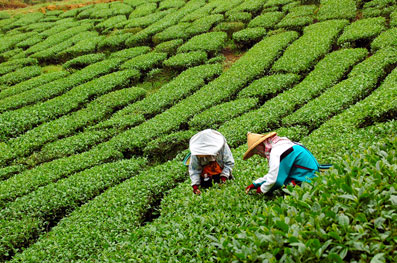A brief history of tea… in China
China is the number one tea producer in the world, producing more than 1 million tonnes per year. It is the only country where all colours of tea are grown (white, green, blue green, yellow, black and dark), since it is the historical birthplace of tea (camellia sinensis), both in terms of production and consumption.

The most famous plantations lie between a latitude of 16° and 34° north, in mountain regions. More than 20 provinces, including Taiwan, produce tea. 6 provinces alone account for 80% of annual production: Zhejiang, Anhui, Hunan, Fujian, Sichuan and Yunnan. The tea growing areas include both large State plantations and small farms.
Where does our tea come from?
We have selected several recipes from ancient traditions.
Flower tea has been produced for centuries. Originally, this was to enhance second grade tea. As a result of its success, mixing flower scents with good quality tea has become an art.
One of the best known, having been all around the world, is the famous Green Tea with Jasmine. Here, we are looking for a good balance between the floral notes of the jasmine and the herbal notes of the tea itself.
Another Chinese "celebri-tea" is the smoky Lapsang Souchong, an Anglo-Saxon phonetic deformation of its Chinese name, Zheng Shan Xiao Zhong. Its origin is purely coincidental. The story goes that, following a flood in his warehouses, a tea farmer had to find a way to get his tea to a British trader in time. The only solution he could think of was to quickly dry the leaves over a wood fire.
The tea was permeated with the smell of smoke and the dealer achieved great success with this tea in England. The following year he ordered twice as much - and smoked tea was born!


